Experience the delicious taste of Germany through this thoroughly authentic homemade bratwurst recipe! Make a double batch, freeze them, and you can conveniently grab and grill a bratwurst any time the craving hits you!

This is a special day because today is the day I’m going to show you how to make bratwurst. And not just any bratwurst. I’m going to share with you my recipe for authentic homemade German bratwurst! With the first bite you’ll immediately recognize that “German flavor” that you know and love from time spent in Germany eating Bratwurst from the German fast food stands. Whether enjoyed whole and served with mustard on a crusty roll or sliced and served as Currywurst, there is nothing quite like a real German Bratwurst!
Boasting over 1500 varieties of Wurst, Germany has long been the world’s Sausage Capital. One such Wurst, the Bratwurst, claims around 40 different varieties itself and has a proud heritage going back hundreds of years where it was first officially documented in 1313. Yes, the savory Bratwurst is synonymous with Germany itself and has remained a cultural icon for centuries.
The term Bratwurst is derived from the Old German word Brät (meaning “chopped” meat) as well as the more contemporary verb braten (meaning “to fry”). While some kinds of sausages are eaten poached, the Bratwurst is first poached and then always pan-fried or grilled.
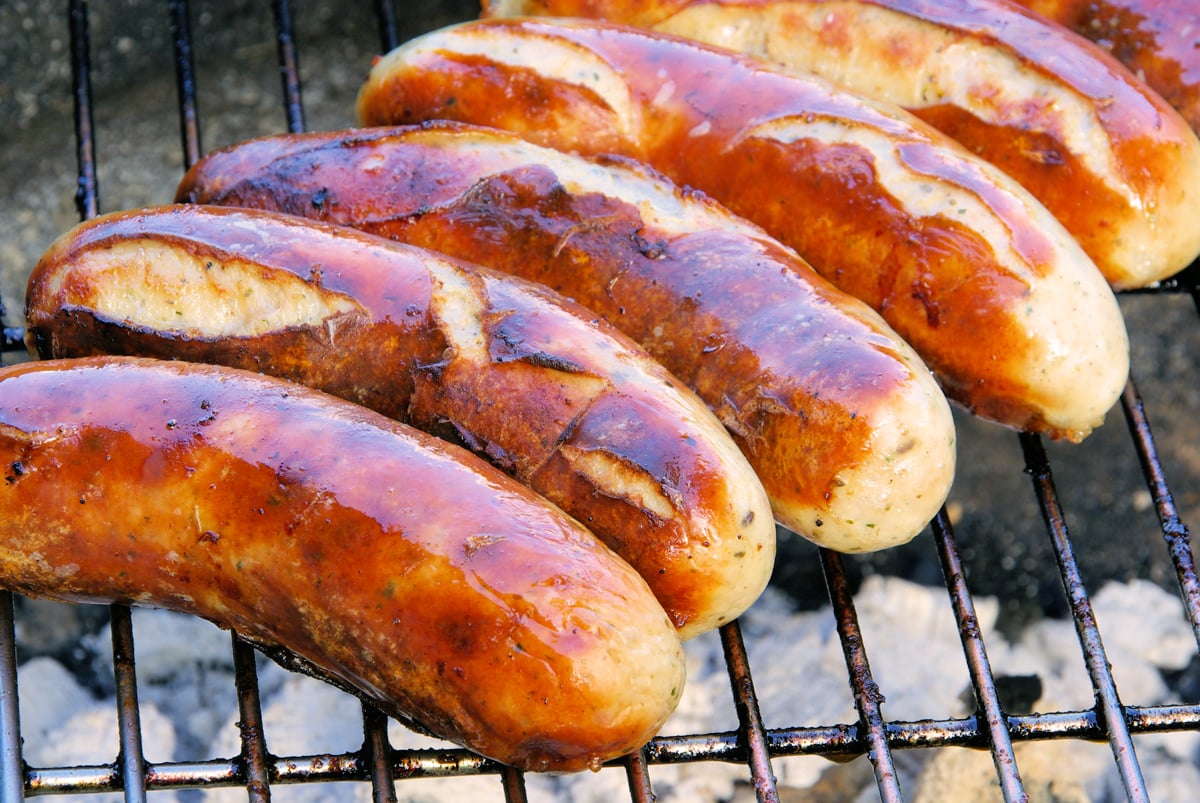 © Lianem|Dreamstime
© Lianem|Dreamstime
Different regions of Germany make their Bratwursts a little differently and the spices and herbs will vary as well the kind of meat used. Some varieties use pork only, some use a combination of pork and veal, some use mostly veal with a little pork, while others use pork with a little beef.
Some of the most popular regional varieties include the Fränkische Bratwurst, Nürnberger Rostbratwurst, Thüringer Bratwurst (very long and thin, my favorite as a kid) and Rote Wurst (from the Swabia region where I grew up and made with the addition of bacon, yum!).
What Do You Serve with Bratwurst?
The most popular accompaniments include a crusty roll cut open and slathered with German mustard or served with sauerkraut, French fries, or potato salad (like this Authentic German Potato Salad).
The Bratwurst is also popularly transformed into the famous Currywurst by slicing the sausages and serving it topped with Curry Ketchup (see our recipe for Authentic Currywurst).

German Red Cabbage (Rotkohl)Semmelknödel (German Bread Dumplings)Kartoffelpuffer (German Potato Pancakes)Authentic German SauerbratenAuthentic German MaultaschenAuthentic German Rouladen RecipeAuthentic German LebkuchenGerman Potato Soup (Kartoffelsuppe)
Home » Food » By Course » Main Dishes » Homemade German Bratwurst
Homemade German Bratwurst
July 11, 2019 by Kimberly Killebrew · 118 Comments
As an Amazon Associate I earn from qualifying purchases. See my disclosure policy.
10368SHARES
- Share
- Tweet
Jump to Recipe Print Recipe
Experience the delicious taste of Germany through this thoroughly authentic homemade bratwurst recipe! Make a double batch, freeze them, and you can conveniently grab and grill a bratwurst any time the craving hits you!

This is a special day because today is the day I’m going to show you how to make bratwurst. And not just any bratwurst. I’m going to share with you my recipe for authentic homemade German bratwurst! With the first bite you’ll immediately recognize that “German flavor” that you know and love from time spent in Germany eating Bratwurst from the German fast food stands. Whether enjoyed whole and served with mustard on a crusty roll or sliced and served as Currywurst, there is nothing quite like a real German Bratwurst!
Boasting over 1500 varieties of Wurst, Germany has long been the world’s Sausage Capital. One such Wurst, the Bratwurst, claims around 40 different varieties itself and has a proud heritage going back hundreds of years where it was first officially documented in 1313. Yes, the savory Bratwurst is synonymous with Germany itself and has remained a cultural icon for centuries.
AD
The term Bratwurst is derived from the Old German word Brät (meaning “chopped” meat) as well as the more contemporary verb braten (meaning “to fry”). While some kinds of sausages are eaten poached, the Bratwurst is first poached and then always pan-fried or grilled.
 © Lianem|Dreamstime
© Lianem|Dreamstime
Different regions of Germany make their Bratwursts a little differently and the spices and herbs will vary as well the kind of meat used. Some varieties use pork only, some use a combination of pork and veal, some use mostly veal with a little pork, while others use pork with a little beef.
AD
Some of the most popular regional varieties include the Fränkische Bratwurst, Nürnberger Rostbratwurst, Thüringer Bratwurst (very long and thin, my favorite as a kid) and Rote Wurst (from the Swabia region where I grew up and made with the addition of bacon, yum!).
What Do You Serve with Bratwurst?
The most popular accompaniments include a crusty roll cut open and slathered with German mustard or served with sauerkraut, French fries, or potato salad (like this Authentic German Potato Salad).
The Bratwurst is also popularly transformed into the famous Currywurst by slicing the sausages and serving it topped with Curry Ketchup (see our recipe for Authentic Currywurst).
 AD
AD
© Jan Sommer | Dreamstime
A Few Recommended Resources
For making sausages you’ll need a meat grinder and a sausage stuffer. Years ago I tried using the Kitchenaid attachments for both of these and as any experienced sausage maker will tell you, they’re downright frustrating if you want to make any more than 2 or 3 sausages. If making sausages is something you’re interested in doing I strongly recommend getting some good equipment that won’t leave you frustrated, vowing never to make sausages again, and that won’t jeopardize the quality of your sausages.
In choosing our sausage-making equipment, my husband and I did a lot of research and chose the items that were great quality without having to pay a fortune.
Which Meat Grinder Do You Recommend?
I use the STX International Turbo Force Electric Meat Grinder. With 3000 watts, 3 speeds and a 3-year warranty, it has high reviews and comes top recommended by most review sites as the best bang for the buck.
Which Sausage Stuffer Do You Recommend?
I also use the Super Deal Heavy Duty 5L Vertical Sausage Stuffer and have been very happy with it. We carefully researched the sausage stuffers on the market and chose this one specifically because of it’s large capacity and 100% metal construction (no plastic parts = not breakable) and it’s also easy to clean.
Which Hog Casings Do You Recommend?
I only use casings from The Sausage Maker. They are sourced from North American hogs whereas other brands source them from China. I use and recommend these hog casings from The Sausage Maker.
Which Sausage-Making Books Do You Recommend?
Once you get the basics of sausage-making down you can experiment with your own flavors and combinations which is what I love to do. But having a few good books with sound instructions for technique and reliable recipes are a must. I have combed through many books on charcuterie and sausage-making over the past few years and these ones continue to be my favorites:
Great Sausage Recipes and Meat Curing by Kutas is a classic and one of the first comprehensive books written on the subject. It’s a no-nonsense, straight-forward book packed full of recipes. Charcuterie: The Craft of Salting, Smoking and Curing by Ruhlman has likewise been a very popular book. The current edition is revised and updated. I have the previous edition and there are inaccuracies and errors in it that the newest edition has reportedly fixed, but I still hear complaints about it. Nevertheless, it’s a great book with some great recipes. Olympia Provisions: Cured Meats and Tales from an American Charcuterie is both a fun and inspiring read. The author, Elias Cairo, is the founder of Olympia Provisions in Portland, Oregon and owns several restaurants and butcher shops there. This book features several of his most popular recipes.
The final two books are both written by Stanley & Adam Marianski: The Art of Making Fermented Sausages and Home Production of Quality Meats and Sausages. While these are a very dry read and don’t have the beautiful photography or inspirational stories the other books have, I consider these indispensable to anyone who is serious about learning the art of charcuterie and sausage-making. Consider them the most comprehensive “how-to” manuals on the market. And if you are planning on dabbling in dry-cured meats, The Art of Making Fermented Sausages is a MUST.
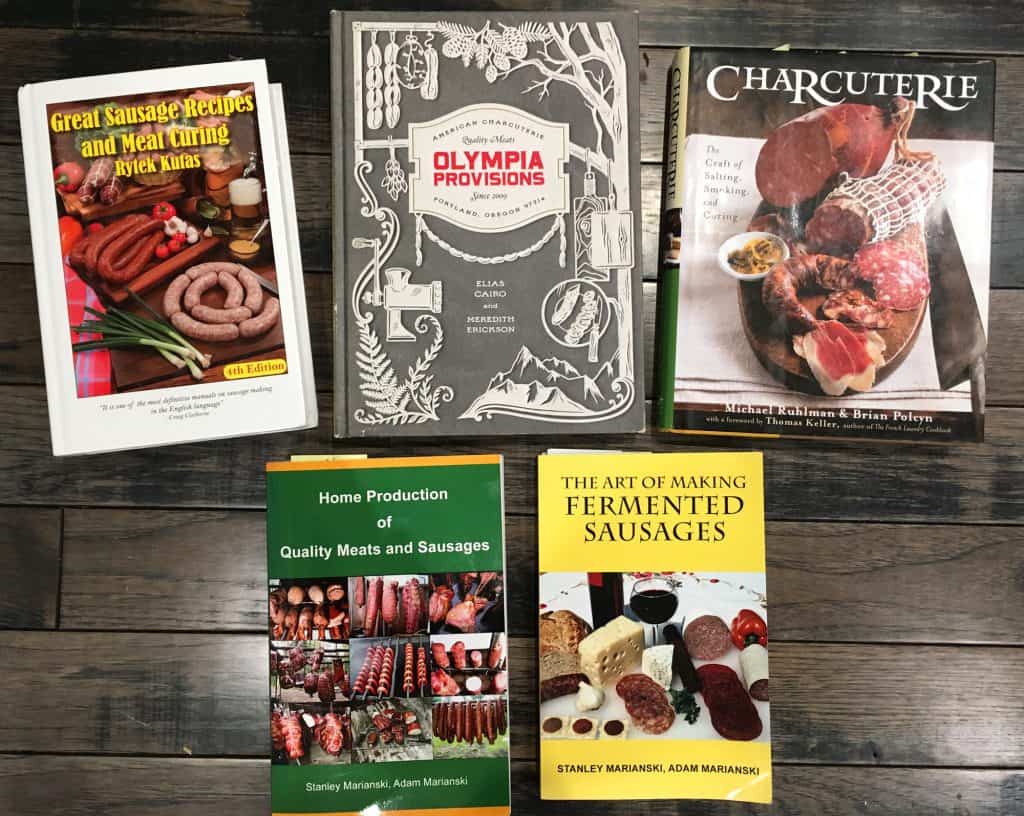 German Bratwurst Recipe
German Bratwurst Recipe
Then let’s get started!
Dice the pork and fat and freeze them for about 45 minutes to get them to a temperature of 32 degrees F (0 celsius).
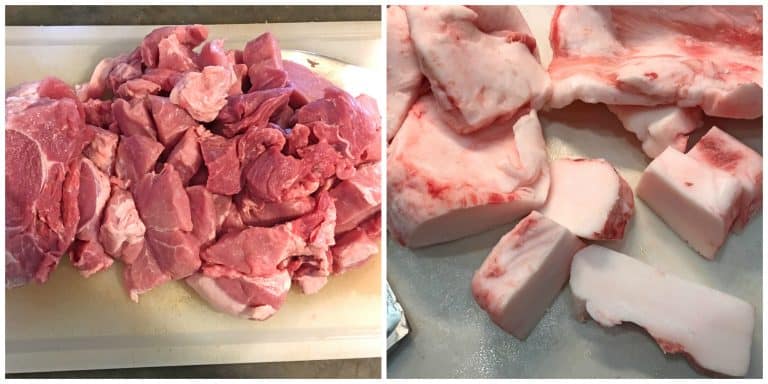
Combine the pork, fat and crushed ice in a bowl and then, working quickly, grind the mixture through a 1/4 inch (6mm) die. Preferably grind the meat mixture into a bowl set atop an ice bath to keep the meat cold. Grind half of the ground mixture a second time. It is imperative that the meat be at a constant cold temperature so that the fat doesn’t get too soft. You should be able to see clear definition between the lean meat the specks of fat in the ground mixture.
Chill the meat in the refrigerator while you assemble the spice mixture.
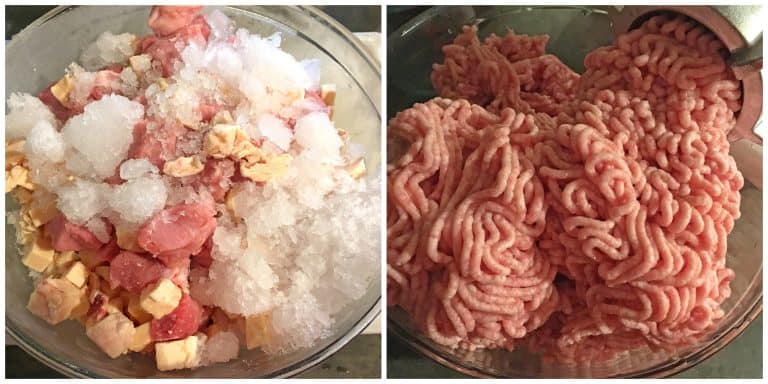
In a small bowl combine all the spices.
Remove the ground meat from the fridge and place it on the stand mixer fitted with a paddle attachment. Add the spice mix and dry milk powder.
Mix the meat mixture with the paddle for 3-4 minutes until threads begin to appear in the meat: If you take a clump of meat and pull it apart with your fingers you will see tiny threads pulling apart. When you see this your meat is ready. If the meat mixture is too dry and stiff, add a little ice water. **If the meat mixture is too dry and stiff, add a littleice water. You want a soft/smooth mixture that will easily go into the casings.
*This is also the time to taste your sausage mixture so you can adjust theseasonings if needed. To do this, take a bit of the meat mixture, fry itup in a pan, taste it and adjust the seasonings if needed.
Place the meat mixture back in the refrigerator while you prepare thecasings.
*This is also the time to taste your sausage mixture so you can adjust the seasonings if needed. To do this, take a bit of the meat mixture, fry it up in a pan, taste it and adjust the seasonings if needed.
Place the meat mixture back in the refrigerator while you prepare the casings.
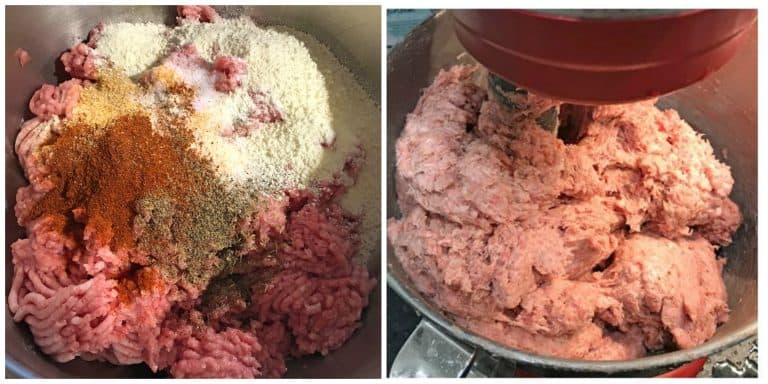
Thread the sausage stuffer with the prepared hog casings, fill the sausage stuffer with the meat mixture, and stuff the casings being careful to avoid air gaps while also being careful to not over-stuff the casings.
Twist the sausages into links. Use a sausage pricker to prick any air bubbles out of the links.
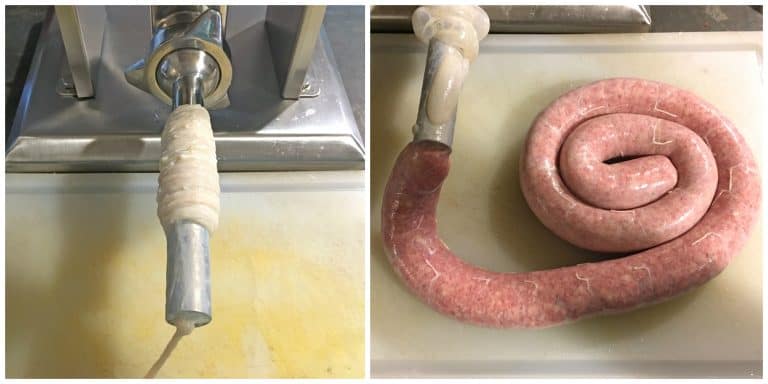
Your Bratwursts are finished. For best results chill the sausages overnight.
To prepare them, gently poach them in lightly salted water and then fry or grill them. Once poached they will keep in the fridge, tightly wrapped, for up to a week.
You can either freeze the Bratwursts raw prior to poaching (then thaw, poach, fry/grill) or freeze them once they’re poached.
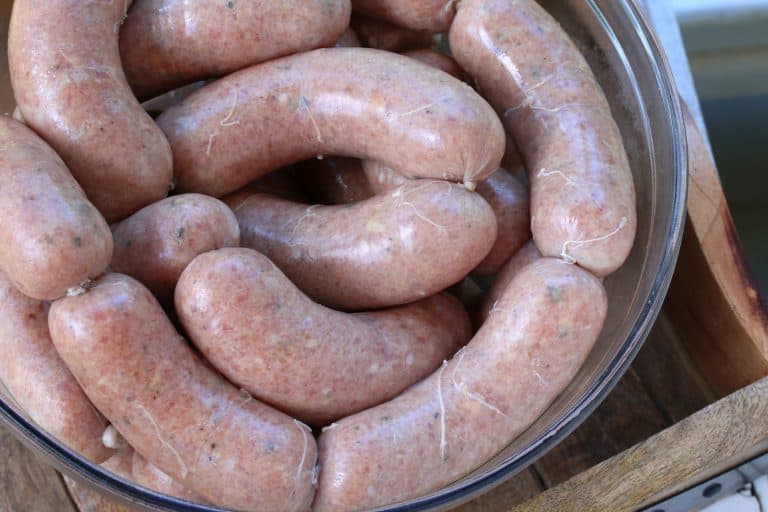
Whether pan-fried or grilled, you’re going to love these Bratwursts!

Source: https://www.daringgourmet.com








